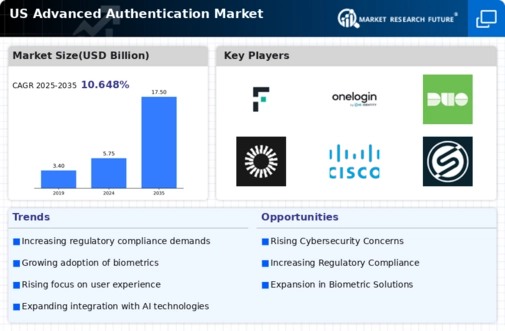The US Advanced Authentication Market is characterized by rapid technological advancements and an ever-changing threat landscape, leading to a competitive environment driven by innovation and consumer demand for security solutions. As organizations increasingly adopt digital technology and remote work practices, the need for robust authentication solutions has gained paramount importance. Companies in this market are focused on providing multi-factor authentication, biometrics, and behavioral analytics to cater to a diverse range of industries including finance, healthcare, and government. This competitive landscape is marked by continuous product improvements, partnerships, and strategic acquisitions to enhance offerings and fulfill compliance requirements.
Furthermore, market players are constantly refining their unique value propositions to differentiate themselves and address evolving threats.Forcepoint stands out in the US Advanced Authentication Market by leveraging its deep expertise in cybersecurity and user experience to deliver effective authentication solutions.
The company’s strength lies in its ability to combine user behavior analytics with advanced threat detection, thereby offering context-aware authentication processes that enhance security without compromising usability. By focusing on behavioral analysis, Forcepoint ensures that its authentication mechanisms adapt dynamically to user behaviors, making it harder for cyber adversaries to compromise access. This unique approach not only boosts security but also minimizes friction for end users, positioning Forcepoint favorably against competitors in the market.
The company's established reputation in cybersecurity, coupled with its innovative solutions, allows it to maintain a strong presence within the US Advanced Authentication space.F5 Networks also plays a significant role in the US Advanced Authentication Market, providing a range of products that enhance digital security and user access management.
The company has developed robust solutions that include adaptive authentication, identity management, and secure access service edge (SASE) capabilities, helping organizations to protect sensitive data in an increasingly complex digital ecosystem. F5 Networks' strength lies in its ability to integrate seamlessly with existing infrastructures, enabling organizations to deploy advanced authentication mechanisms efficiently. The company has pursued a strategy of strategic mergers and acquisitions to bolster its capabilities, acquiring firms with complementary technologies aimed at enhancing its authentication portfolio.
This expansion has allowed F5 Networks to solidify its position in the US market and continue to provide innovative solutions that meet the growing demands for advanced security in an evolving landscape.























